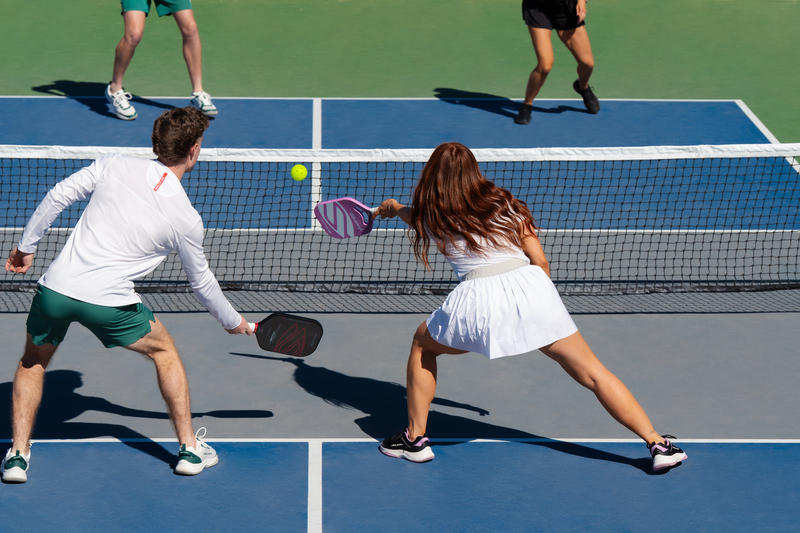If you are showing up to a pickleball open play and there are enough people for more than one court, sometimes it can be confusing how to cycle those courts so you are not playing the same players over and over. There are a few different ways you can do this.
Round Robin
Round Robin can be a confusing form of pickleball rotation, mainly because you need a highly-organized leader to run the game. The great thing about Round Robin is you can play it even if players of all different skill levels show up.
- When you show up, the Round Robin captain should assign you a number.
- You will be assigned to play with three other players for your first game.
- You will play your game within an allotted time. If your game is not finished within the allotted time, the team with the higher score will win.
- The Round Robin captain will organize the courts and tell you which court to move to next.
- If all goes correctly, you should be playing six games with six different partners and different opponents.
- Depending on the number of players who show up, do not be surprised if you have a “bye” during your session.
Download the PlayMore app and start planning Round Robin pickleball.
King of the Court
AKA Queen of the Court / Up River / Down River / Ladder / Waterfall
King of the Court (also known as Queen of the Court, Up River/Down River, Ladder, or Waterfall) is another great play format for pickleball, especially if players with many different skill levels show up.
- Players will be assigned their first court based on their skill level (rating).
- Lower-rated players will start on Courts 1, 2, etc. and higher-rated players will start on Courts 5, 6, etc.
- Games can be timed or played to 11, depending on who is running the court.
- If the games are timed, then the team who is winning at the end of the time will win.
- If the games are played to 11, many times you will go to Rally Scoring after the first team(s) complete their games.
- After the first game, the winners will move up a court and split onto either side of the net.
- Some formats will allow the winners to stay together.
- After the first game, the losers will move down a court and split onto either side of the net.
Challenge courts
If you have more players than you have room for players, then challenge courts are a great option. In this example, assume you have one court and six people who want to play. This is how it would be run:
- Four players play a game on the court.
- The winners stay on the court together as a team (you do not split to different sides of the court).
- The challengers put up their paddles or names in groups of two.
- Winners stay forever (until they lose) or there's a set number of games (usually three) before they have to relinquish the court.
- Then, either four new players come on (because the winners are leaving) or the losers stay (usually if only one team is waiting to play).
- This format can be played endlessly until everyone is done playing.
Numbering
Numbering is a simple way to rotate during open play. The downside of the numbering system is that, if you have a varying level of skills, players may continually end up on courts with players much more, or less, skilled than they are. To run a numbering system:
- Before the first game, players will stand in a circle.
- Depending on the number of players and courts, players will number off.
- For instance, if you have six courts and 24 players, players will number themselves 1 to 6.
- Players will then go to their courts and play their game.
- You can either set a time limit or allow each court to play their game to 11.
- Usually games will move to rally scoring once the first one or two games are complete.
- Once the first game is done, players will again stand in a circle and number off.
If you are a competitive player, numbering may not be the best system for you. It’s more of a way to have fun open play pickleball where you can experience playing with a lot of different people in the same session.
Public court open play
- If you show up to a public court with no organization, then the rules of open play apply. This is usually done with some sort of paddle rack or other system to signify who is next.
- Pickleball open play is usually first-come, first served.
- When you show up (and if there is a wait), you should place your paddle in the paddle rack to save your spot in line.
- Play should be done on a rotational basis (usually 2 on/2 off or 4 on/4 off) depending on the rules of the facility and the number of courts.
- At most locations, double pickleball will have priority over singles pickleball.
There are different ways of determining who is next:
- If it's 4 on/4 off, the winners and losers put their paddles in different designated buckets or racks. Then, there is a ball or marker that says whether the losers or winners rack/basket gets the next game (to better distribute folks if it's very busy).
- If it's 2 on/2 off, usually it's winners stay and split.
- There are some places that use a white board and the next square with four names is up. If you don't want to play with the people who have less than four names in their box, you can put your name further back, but cannot skip ahead.
Different courts will usually have their own rules, so pay attention to those rules and be respectful of how they specifically want the game played.
Download the PlayMore app and start planning pickleball with your friends.

